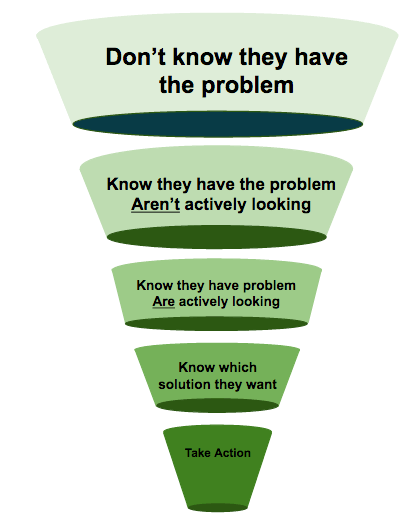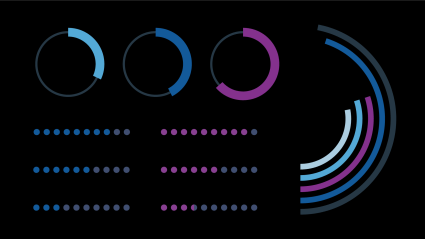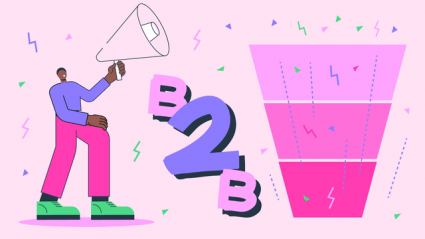When it comes to B2B software, marketing can be just as important as product.
The outcomes of poor B2B marketing include unsustainably high customer acquisition costs and lackluster customer volume, either of which can sink a business. It’s important to remember that these outcomes are not offset by product quality. When a great product meets bad marketing, the end result is still failure.
Even worse, with bad B2B marketing potential customers may hear about your product, but because of ineffective messaging they may not realize the potential value of your product to their business, As a result, they might write it off altogether – maybe even in favor of a competitor who has better alignment between messaging and product.
Despite the importance of marketing for B2B software companies, up until now, there hasn’t been a thorough marketing resource that comprehensively explains both the strategy and the actionable tactics involved in B2B marketing. Realizing that there was a real need for just such a resource, we teamed up with Growth Rock, a CRO agency with plenty of experience working with top B2B companies, to put together a comprehensive two-part guide to performance marketing and landing page optimization for B2B software companies, which is now available for download.
In this post, we want to take a deep dive into a topic discussed in that guide: the importance of messaging for B2B marketing, and how to do it effectively.
The Hidden Costs of Ineffective Messaging
As discussed earlier, the costs of bad marketing are often underappreciated. This is often the case with messaging in particular, because of the hidden costs of ineffective messaging.
Ineffective messaging leads to a worst-case scenario since it results in a lose-lose. You lose a potential customer (i.e. both revenue and a new client relationship that could lead to others), and they miss out on a product that could positively impact their business.
But that’s not all. If you get messaging wrong, you might create negative awareness of your brand, causing prospective customers to think of your product as irrelevant or not meaningful for their business.
People are habitual thinkers, so this is a serious problem that can hurt your marketing down the line. Just like it’s hard to unlearn bad habits once they’ve become ingrained, it’s hard for prospective customers to unlearn a false impression that your product isn’t useful or relevant to them.
In fact, it would almost be better for you to be unheard of by potential customers than to be remembered negatively. Remember that perception does not equal reality; a good product marketed poorly can create a negative impression.
And in a B2B context, this can be especially problematic, since there’s a far smaller pool of potential customers than there are for consumer-facing businesses who can more easily afford broad “awareness” campaigns with generic messaging that might turn off some of their potential customers.
Most B2B companies are painfully aware that a poor product can be very costly to their reputation, but so can marketing failures through ineffective messaging – a fact that is overlooked too often. And keep in mind that with ineffective messaging in performance marketing, you’re actually paying for your own bad reputation.
Luckily, you can avoid ineffective messaging if you put in the work upfront to get the fundamentals right. Truly effective messaging transforms the effectiveness of your marketing channels throughout the entire conversion funnel.
Messaging Fundamentals For Performance Marketing
As a paid marketing agency that helps some of the best-in-class B2B companies allocate millions of dollars annually, we have witnessed firsthand how strategic messaging can make or break a performance marketing campaign on channels like LinkedIn, Facebook, and Google.
A good rule of thumb is that the more relevant messaging is to a prospective customer, the more effective it will be. While this seems fairly obvious, relevance can be broken down into two basic components: relevance to a target customer profile, and relevance to a prospect’s stage in the marketing funnel.
If you have built out a clear understanding of both of these components, you will have a clear direction when you’re coming up with what marketing messaging to develop for a given target customer profile. By having this understanding you’ll be much less likely to waste time and money on frivolous tests that don’t have any real impact on performance. You’ll also reduce the likelihood of turning potential customers off with irrelevant messaging that doesn’t address their concerns, or that doesn’t effectively communicate your value proposition.
Below we explain our process for building out target customer profiles and conceptualizing the marketing funnel as it relates to messaging.
Messaging By Target Customer Profile

It’s a mistake to try and create generic messaging aimed at everyone who could possibly become a paying customer. As the saying goes, instead of pleasing everybody, you’ll end up pleasing nobody. Specific messaging aimed at a particular target customer profile is crucial to effective paid acquisition.
While it takes more work to incorporate this messaging into your performance marketing, since it will necessitate variations in ad copy, ad creative, and landing page content, the returns will end up outweighing that investment by far.
Specific messaging can only be crafted with a specific persona in mind. This is a little more complicated for B2B companies, since for them customers are organizations, not people. As a result, multiple decision makers are often involved in a purchase decision.
So there are actually two dimensions of a target customer profile for B2B. First, what kind of organizations are you targeting? And second, who within the organization are you targeting? At Wpromote, we define target personas for B2B clients by four criteria: two related to the target organization, and two related to individuals (within a target organization):
- Company size (organization)
- Vertical (organization)
- Job Title (individual)
- Motivation (individual)
Company Size
Effective messaging depends heavily on the size of the company being targeted. Small companies are qualitatively different than enterprise; an established corporation is not just a bigger version of a startup. There are emergent properties of size, scale, and complexity that change the fundamental nature of an organization as it grows.
Because they change at a fundamental level, companies at different sizes will want different things. For example, startups are focused on rapid growth and are likely to be receptive to things that can rapidly improve their business. Established corporations want to maintain and slowly expand their market share over the long term, and want pragmatic tools with proven return on investment.
The point is that the same product can (and should) be two different things to two different companies if marketed correctly.
Let’s say your product is an email marketing automation tool and your customer persona is a small startup. Your messaging should emphasize the potential for rapid growth with your tool. It could also emphasize the relatively low cost for smaller teams since startups are often operating against tight budget constraints, and the ease of adoption, since startups need to make decisions on the fly and don’t have time for long, complicated onboarding.
For the same product but a different target persona – an established enterprise company – your messaging should package and present your product as the industry standard since established companies are risk-averse and don’t want to fall behind the curve. You can point to case studies and statistics about the improved open rates, positive return on investment, and higher customer engagement using your email automation tool over competitors or in-house tools.
Finally, who you are targeting is going to change between bigger and smaller organizations, and so will the messaging. Messaging for big companies will have to be broad enough to apply to all the stakeholders involved in a purchase decision (from practitioners to C-level executives). Startups, on the other hand, are much more horizontal in structure and have less stratification. A startup founder will be able to appreciate messaging that emphasizes product features and benefits because they are often practitioners themselves (or recently have been), whereas corporate executives rarely share much perspective with ground-level practitioners, except when it comes to business-wide benefits.
Vertical
The vertical of a target customer profile should impact your messaging as well as company size, especially if you have different product features that users in different verticals will find useful.
An e-commerce company that sells high-end women’s clothing, for example, will want very different things from an email marketing automation product than a B2B company that sells invoice management software.
The former might want email templates with colorful and eye-catching design templates, dynamic product offerings personalized by browsing behavior, and other design features. The latter might want to send a nurturing campaign to users who have signed up for a demo but haven’t converted into a customer, and might be more interested in automated triggers and time-interval A/B testing.
Your messaging should reflect this by emphasizing different features and benefits of your product in your ads and landing pages. There is a stark economy of messaging in a given advertising unit, with platform-enforced limits on time and space. These limits force advertisers to prioritize certain benefits and features at the cost of others.
The same applies to the “above the fold” messaging of a PPC landing page. Although in theory you could list every possible benefit and feature of your product on a landing page, since there are no externally-imposed length limits, people have short attention spans and at the least, it is important to put the features and benefits you want to emphasize near the top of the page.
Job Title

Messaging will also be more effective when it is relevant to the actual individual receiving it. People don’t think like companies, they think like individuals. First and foremost in their mind when they see an ad is the question “how is this relevant to me?”
As mentioned earlier, job title is one aspect of the individual target customer profile that can have significant implications for larger companies. Advertising platforms like LinkedIn enable you to directly target people based on their job title. So, for example, you might have two different audience segments at different levels of seniority if you’re an email marketing automation company: marketing managers and CMOs.
CMOs are concerned with big-picture, business wide objectives. It makes less sense to emphasize product features if the target is a CMO, who might have enough familiarity with day-to-day operations to recognize that a particular feature is useful, but may not automatically connect the dots to how it’s relevant to them.
One of your product features might mean greater ease of designing email templates, for example. This leads to less time spent on implementation, which leads to more time for testing and strategizing, which leads to greater ROI from email marketing budget, which positively impacts growth and the overall marketing ROI. A CMO will only care about the last step in this chain of inferences, because that’s what they’re accountable for. Good marketing is about cutting to the chase, about reducing the amount of mental work a busy CMO will have to do to recognize the value of your product.
Vice versa with the marketing manager. The business-wide benefits of other companies who’ve purchased your product, which you might emphasize to a CMO, will matter little to them. On the other hand, granular benefits and features that make their day-to-day easier or more productive, and allow them to drive better results that they can then point to as wins, are what will motivate them to act.
Motivation
Closely related to job title is motivation. What are the major pain points different customer profiles currently experience, either as a result of using a competitor’s product or because they aren’t currently employing any solution?
A call to action is the punchline of any messaging. But whatever precedes it should motivate the ad viewer to actually take that action, by framing their existing motivations in term of your product.
Kelly, a marketing manager at a small financial services startup, just spent the last three hours in a frustrating attempt to create an automated lead nurturing campaign. She finally did it, but she has a hundred other things on her plate for the day. Feeling overwhelmed, she takes a break and starts absentmindedly browsing LinkedIn.
She sees an ad. “Want better ROI from your email marketing campaigns?” is the headline, and she browses right past it. She didn’t spend the last 3 hours trying to improve ROI, she spent them trying to set up a working nurturing flow.
She sees a second ad. “The Easy Way To Set Up Customizable Lead Nurturing Campaigns”. She stops scrolling and she can’t click through fast enough. Ten seconds later she has set up a trial account and is creating her first campaign.
Knowing your customer’s motivations lets you market your product on a psychologically compelling level. And using the right messaging goes a long way towards this.
Messaging By Stage Of The Marketing Funnel
You can know everything there is to know about a target customer profile, and still get the messaging wrong. Why? Because the same person at different times needs to hear different things according to their level of awareness.
In marketing, the different levels of awareness are often visualized as a funnel. Those higher in the funnel have the least awareness of your product, and are statistically the least probable to convert into a lead or a paying customer as a result, on the basic principle that more touch points = higher awareness = greater product familiarity = greater likelihood of interest.
At Wpromote, we use a model with five stages of awareness to help determine how best to reach a prospective customer at different points in the funnel, depicted below:

For a full explanation of each stage in this funnel and how it impacts our advertising goals, choice of platform, targeting, and bidding strategies, see our full guide.
For our purposes in this post, we’ll focus on how the funnel applies to messaging.
In Stage 1 (top of funnel), prospects don’t know they have the problem your product solves. They are experiencing a pain point without recognizing it as such. For prospects at this stage of the funnel, messaging should focus on defining the problem and building awareness that it is a problem, with the goal of moving them to…
At Stage 2, they know they have the problem your product solves, but aren’t actively looking for a solution yet. At this stage, it’s a matter of priming. They’re aware of a problem they’re experiencing, and now it’s time to convince them that it’s worth acting on by framing it as more important than any number of other problems they deal with on a daily basis. The idea is to get the problem out of the “I’ll fix it eventually” bucket and move it to the “I need to fix this, it’s a priority” bucket.
Once they’re convinced the problem is worth acting on, the prospective customer should move to stage 3, where they are actively looking for a solution. This is the stage at which a prospective customer is likely to start researching their options, and the goal of your messaging should be to emphasize the benefits of your product in particular, showcasing how your product solves the prospect’s pain points and other benefits and features that help the prospect understand your product’s value.
At stage 4, prospects have narrowed down their options and are comparing solutions. This means that they’ll likely be looking at your competitors, and it’s important to take this into account in your messaging. You should emphasize the comparative benefits and unique features of your product.
You should also include promotional messaging (if applicable) to further motivate prospects to choose you over your competitors, and build a sense of urgency to encourage them to stop shopping around and make a choice (in your favor). Messaging such as “50% off your first month if you sign up in the next 10 days” may be fitting for someone at this stage of the funnel.
Let’s look at an example to clarify how messaging according to the funnel should work. In Kelly the marketing manager’s case, as described in the previous section, Kelly falls smack-dab in the middle of the funnel. She’s painfully aware that she has a problem (hours wasted on a single nurturing campaign) but hasn’t yet been shopping around for other solutions. Your messaging (as demonstrated in the second LinkedIn ad example in the previous section, “The Easy Way To Set Up Customizable Lead Nurturing Campaigns”) should speak to that by addressing her pain points and emphasizing benefits and features of your product that will solve that pain point for her.
Tying It All Together
The underlying logic of effective messaging is simple: show a prospective customer why your product is relevant to them, so that they don’t have to figure it out themselves.
People often labor under a high cognitive load at work. Even though they could figure out the value of your product on their own, many would rather save the mental effort and invest it elsewhere. Effective messaging reduces how hard people have to work to realize your product value.
The key is that the same messaging performs differently for different people, and that’s because of relevance. What’s relevant to one person is not necessarily relevant to another person. Target customer profiles will help you logically develop and test messaging according to the prominent segments of your prospective customers.
As you get more and more granular with a target customer profile, the relevance will increase, but bear in mind that the law of diminishing returns operates here, and your messaging will never be 100% percent relevant to every audience you reach. The goal is to come as close as you realistically can to addressing the differing needs and mindsets of your target audiences.
But there’s a complication: what counts as effective messaging for the same potential customer will vary over time; to be precise, over the course of their progression through the marketing funnel. Messaging that resonates for someone at different points of the marketing funnel can differ as much as what resonates for different customer profiles.
That’s why a model of the marketing funnel, such as the one we’ve described in this article, is useful for developing messaging. It lays out the specific concerns that must be addressed at each stage of the funnel, which will apply generally across customer profiles. This makes messaging for the funnel an easily repeatable process, but one that it is important not to overlook.







Responses